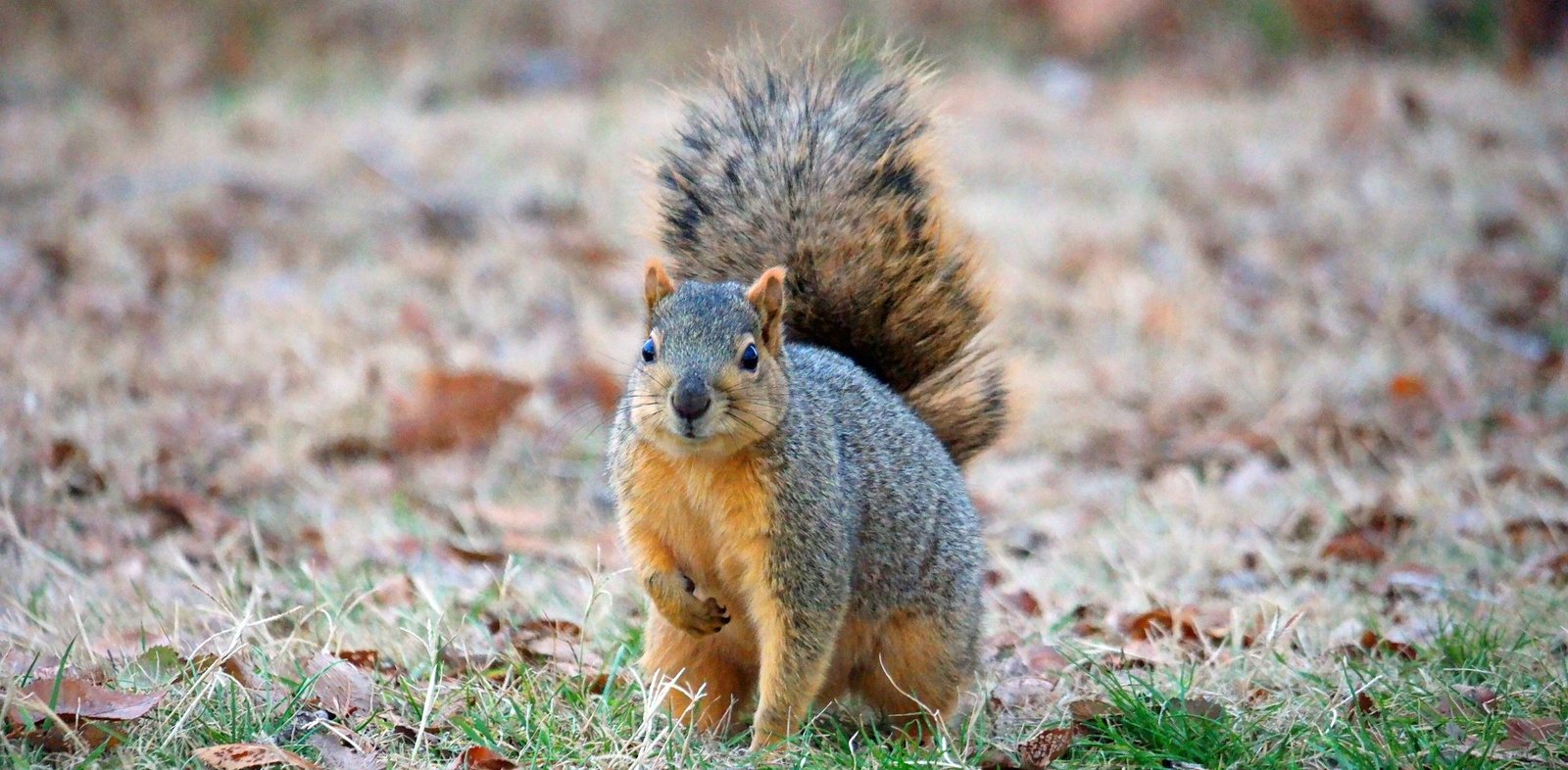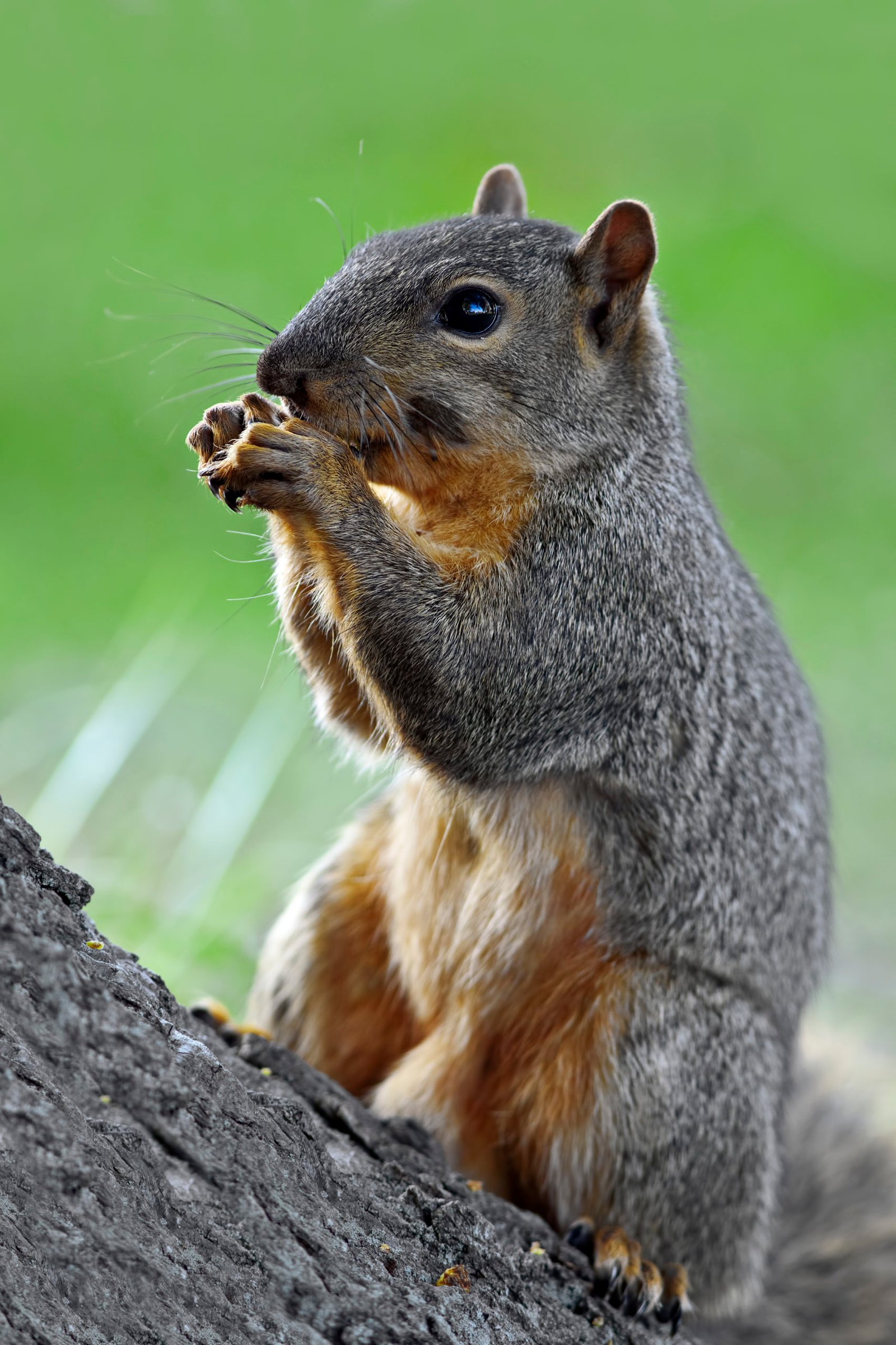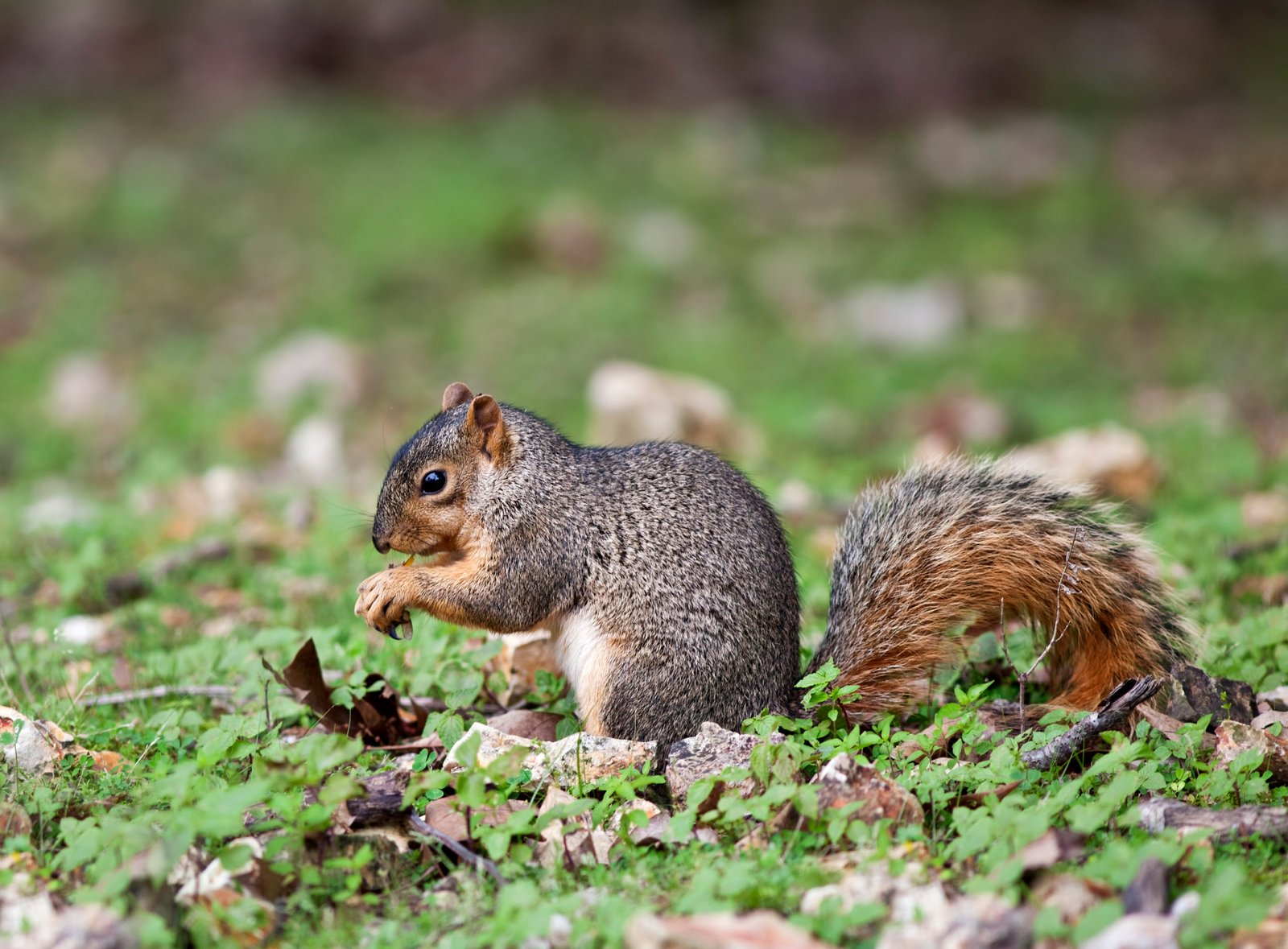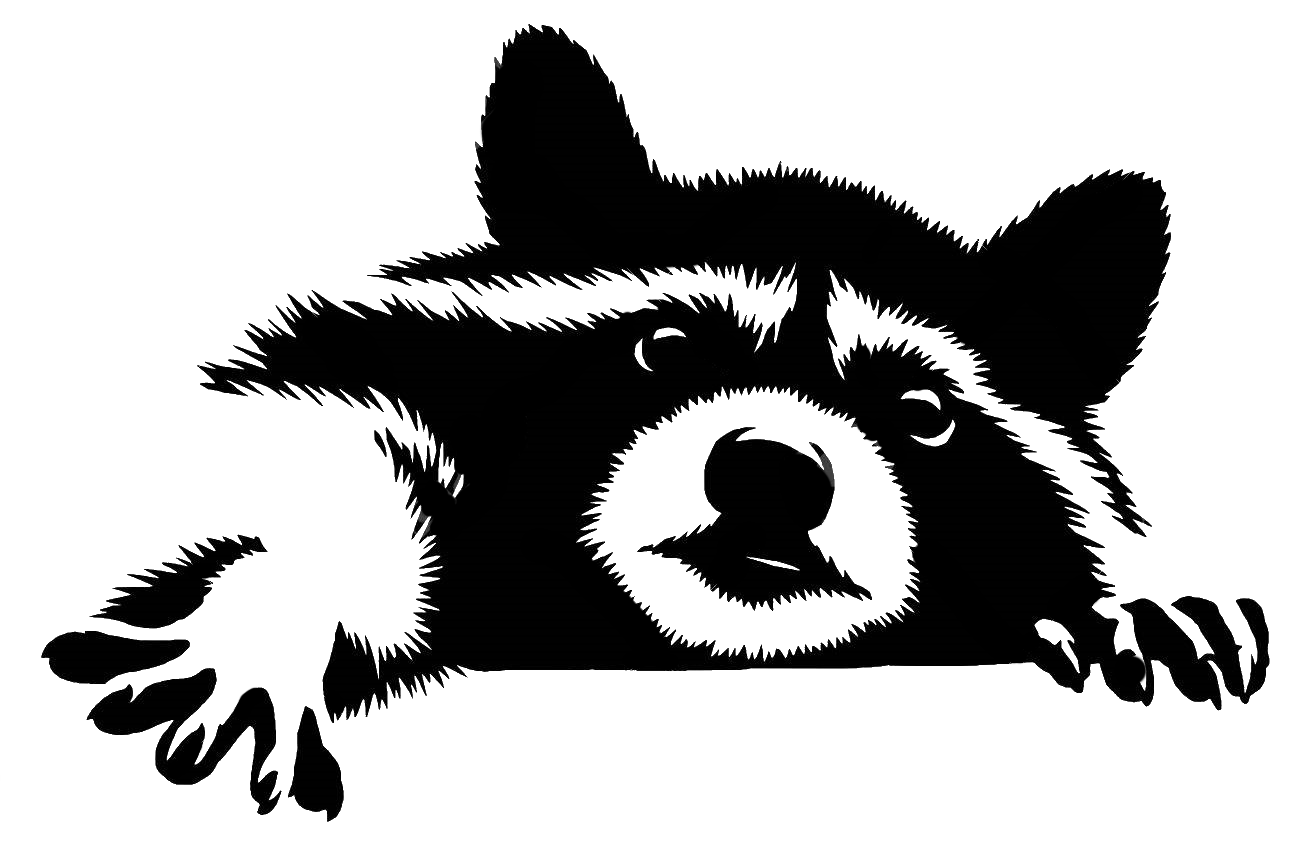Fox Squirrel: Glaucomys Volans

Description Of The Fox Squirrel
Weighing from one to three pounds, the fox squirrel (Sciurus niger) exhibits color variations ranging from a buff color to gray, and sometimes black. The lower parts are generally lighter, and typical specimens have black faces and feet with white noses and ears.
They are known for their long, bushy tails and their strong hind legs, enabling them to jump from tree to tree easily. There are 20 teeth in the skull of a fox squirrel. Because of its relatively large size and peculiar way of running along the ground, which gives a small fox’s appearance, the fox squirrel was named after the fox. 1Go To Source myfwc.com -“Fox Squirrel Sciurus niger”
Learn More: North American Squirrel Species
Fox Squirrel Habitat
Fox squirrels prefer open habitats that are savannah-like, where trees are widely spaced, and the understory is open. They are most prevalent in oak-hickory forests but are also found in live oaks, mixed forests, cypress and mangrove swamps, and pine forests.
Fox squirrels tend to thrive in suburban and urban settings due to this habitat preference. Unlike their close relatives, grey squirrels are rare in heavily forested areas.
To build nests to raise their young, the Fox squirrels need large trees with cavities or holes in them. They may also use these cavities to hibernate in the winter. They also construct leaf nests, a collection of leaves that are used by adults in the branches. High up in the larger trees, they build leaf nests. Large oaks, elm trees, and other hardwood trees are usually used. 2Go To Source biokids.umich.edu -“Fox squirrel Sciurus niger”
Range Of Fox Squirrels

The species’ natural range extends to southern Canada, the eastern United States, and northern Mexico. Meanwhile, in British Columbia and Ontario (Canada) and California and Washington in the western part of the US, populations of the Eastern fox squirrel have been introduced.
Open woodland with open understory and a scattered cover of trees is the preferred habitat of this rodent. The Eastern fox squirrel favors living among oaks, hickories, walnuts, and pines within this habitat. It is also known that this species occurs in hedgerows and timbered fencerows adjacent to prairies. This habitat type is also found in urban areas where it is occasionally possible to observe the Eastern fox squirrel.3Go To Source animalia.bio -“EASTERN FOX SQUIRREL”
Fox Squirrel Diet
The fox squirrel’s diet is quite varied but mainly consists of tree nuts such as oak, walnut, pine nuts, and other various seeds. The eastern fox squirrel also consumes other grains, fruits, buds, flowers, bark, twigs, sap, fungi, and crops such as corn, wheat, and soybeans. Some animal food, such as insects, birds and their eggs, and even dead fish, are occasionally consumed.
The fox squirrel has also been known to gnaw on bones and antlers to obtain calcium and other minerals. By burying them in the ground, this species stores nuts, giving it a food supply for the winter months. Many of these nuts have never been recovered and may sprout into new trees. 4Go To Source ovlc.org -“EASTERN FOX SQUIRREL SCIURUS NIGER”
Behavior Of Fox Squirrels
Large tree squirrels are Fox squirrels. They are Texas’ most common squirrels because of their ability to adapt to a wide range of forest habitats. Their largest distributions occur in upland forests that contain a mixture of nut tree and oak trees. Fox squirrels are an important game animal, but their fondness for maize and pecans often leads farmers to regard them as pests.
Early in the morning and late in the afternoon, squirrels are usually active. In holes in trees, Fox squirrels nest or build leaf and twig nests. Acorns and other nuts, buds, fruits, fungi, insects, amphibians, and the inner bark of trees are eaten. For winter food, squirrels bury nuts and relocate the nuts by smell. Squirrels only find a portion of the nuts they bury and end up as essential nut tree planters. During the course of 3 months, a single squirrel may bury several thousand pecans.
For a range of purposes, the long bushy tails of squirrels are used. To keep them warm, they can be wrapped around the face of a squirrel, used as a balancing aid when running along tree limbs, or spread and used as a parachute if the squirrel should fall. Watching a squirrel’s tail movements offers you a clue to their mood with a little practice. The tail’s rapid jerks signal that they are nervous or upset. 5Go To Source tpwd.texas.gov -“Eastern Fox Squirrel (Sciurus niger)”
Fox Squirrel Reproduction Habits

Females can mate with several males, but to determine who gets to mate first, the males will compete with each other.
Fox squirrels will mate at any time throughout the year; in December and June, this behavior peaks. Before estrus, males follow females, smelling the perineal region. In a female’s home range, males aggregate when she begins estrus.
To determine mating privilege, dominance hierarchies form among the males. The copulation lasts less than thirty seconds, and with several males, females can mate. Following mating, a copulatory plug forms. The gestation period lasts for 44-45 days. The average litter size is 2-3, but the litter size varies from 1 to 7.
Young squirrels are born naked, weighing about 13-18 g. The eyes open at week 5, and at week 8, the young are weaned. Sexual maturity is achieved for females at 8 months and males at 10-11 months. In a year, females can produce 2 liters. 6Go To Source animaldiversity.org -“Sciurus niger eastern fox squirrel”
Common Predators Of The Fox Squirrel
- Weasels
- Foxes
- Cats
- Bobcats
- Hawks
- Coyotes 7Go To Source dnr.state.mn.us -“Fox squirrel”
Sources:
- “Land Mammals – Fox Squirrel.” Florida Fish And Wildlife Conservation Commission, Florida Fish and Wildlife Conservation Commission, myfwc.com/wildlifehabitats/profiles/mammals/land/fox-squirrel. Accessed 25 Jan. 2021.
- Fahey, B. 2001. “Sciurus niger” (On-line), Animal Diversity Web. Accessed January 25, 2021 at http://www.biokids.umich.edu/accounts/Sciurus_niger/
- “Eastern Fox Squirrel – Facts, Diet, Habitat & Pictures on Animalia.Bio.” Animalia, Animalia, animalia.bio/eastern-fox-squirrel. Accessed 25 Jan. 2021.
- Ojai Valley Land Conservancy. “Eastern Fox Squirrel.” OVLC, OLVC, 10 July 2014, ovlc.org/ojai-wildlife/eastern-fox-squirrel/#:%7E:text=The%20diet%20of%20the%20eastern,as%20corn%2C%20wheat%20and%20soybeans.
- “Eastern Fox Squirrel (Sciurus Niger).” Texas Parks & Wildlife, TPW, tpwd.texas.gov/huntwild/wild/species/easternfoxsquirrel. Accessed 25 Jan. 2021.
- Fahey, B. 2001. “Sciurus niger” (On-line), Animal Diversity Web. Accessed January 25, 2021 at https://animaldiversity.org/accounts/Sciurus_niger/
- “Fox Squirrel.” Minnesota Department Of Natural Resources, Minnesota DNR, www.dnr.state.mn.us/mammals/foxsquirrel.html. Accessed 25 Jan. 2021.
